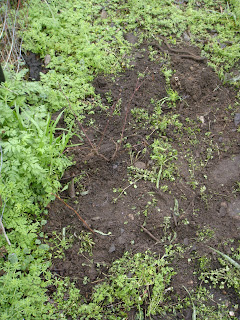 Below is a list of what I started with, and following it is what I have now:
Below is a list of what I started with, and following it is what I have now:- Habanero pepper= I now have 1 doing OK and the other is stalled.
- Jalapeno pepper= all died
- Bell pepper= 2, both doing OK
- An Anaheim-type pepper= all died
- Hungarian wax pepper= 1 left, all but dead.
- Pepperoncini pepper= all died
- Roma Tomatoes= 1 stalled, 1 doing pretty good
- Beefsteak Tomatoes= all died
- Cherry Tomatoes= 1 massive bastard:
 All in all, this is a pretty damn miserable performance. I started with about 4 seeds/peat pot and five peat pots, so out of 20 seeds I got about 1 is potentially useable plant. I figure I had about a 50% germination rate, most of the seedlings didn't survive, and then a few more died in the transplanting.
All in all, this is a pretty damn miserable performance. I started with about 4 seeds/peat pot and five peat pots, so out of 20 seeds I got about 1 is potentially useable plant. I figure I had about a 50% germination rate, most of the seedlings didn't survive, and then a few more died in the transplanting.For the life of me I can't figure out why so many have failed. They are in good soil, get a regular amount of high quality light, and are kept moist (but not wet) by regular spritzes. I also water them with a 1-2-1 fertilizer (as recommended by the folks at ANG) every few weeks, diluted into the spray bottle. The stalks of the plants are very strong but the leaves are shriveling, drying, and dying.
I saw this coming a few weeks ago and ordered some new seeds to try and get something going:
Black Krim, a Russian Heirloom Tomato ("In Russia, Tomatoes grow you!")
Ceylon Tomatoes (a mini-beefsteak), because my other beefsteaks died.
Early Jalapeno, because I love Jalapenos and they are one of the reasons, if not the reason, why I started a garden.
Ancho Poblano Peppers, I would like to try and dry these.
"White Lightning" Habanero, because my Habaneros died and these look pretty cool.
While the seedlings have been pretty disapointing the stuff out in the yard and in the box has been going great. The peach tree, in particular, is starting to bloom:
 I also bought a lemon tree a few weeks ago at Great Outdoors. Even here in Central Texas it gets too cold for a lemon tree to survive year-round planted in the ground. I keep this one inside in a sunny window in the back bedroom but I may move it outside during the summer. Its already got six little lemons on it.
I also bought a lemon tree a few weeks ago at Great Outdoors. Even here in Central Texas it gets too cold for a lemon tree to survive year-round planted in the ground. I keep this one inside in a sunny window in the back bedroom but I may move it outside during the summer. Its already got six little lemons on it. The veggies are also going pretty strong. This is the lettuce, mesclun greens, and carrots (from the front of the picture to the back) and all nine spots of each have sprouted:
The veggies are also going pretty strong. This is the lettuce, mesclun greens, and carrots (from the front of the picture to the back) and all nine spots of each have sprouted: All nine buttercrunch lettuce have come up as well:
All nine buttercrunch lettuce have come up as well: And all four peas:
And all four peas: So in the box, I'm batting a thousand. All seeds have sprouted and all the seedlings are doing very well. And though I didn't take a picture of it, the potato runners are also nearly up to the surface.
So in the box, I'm batting a thousand. All seeds have sprouted and all the seedlings are doing very well. And though I didn't take a picture of it, the potato runners are also nearly up to the surface.













